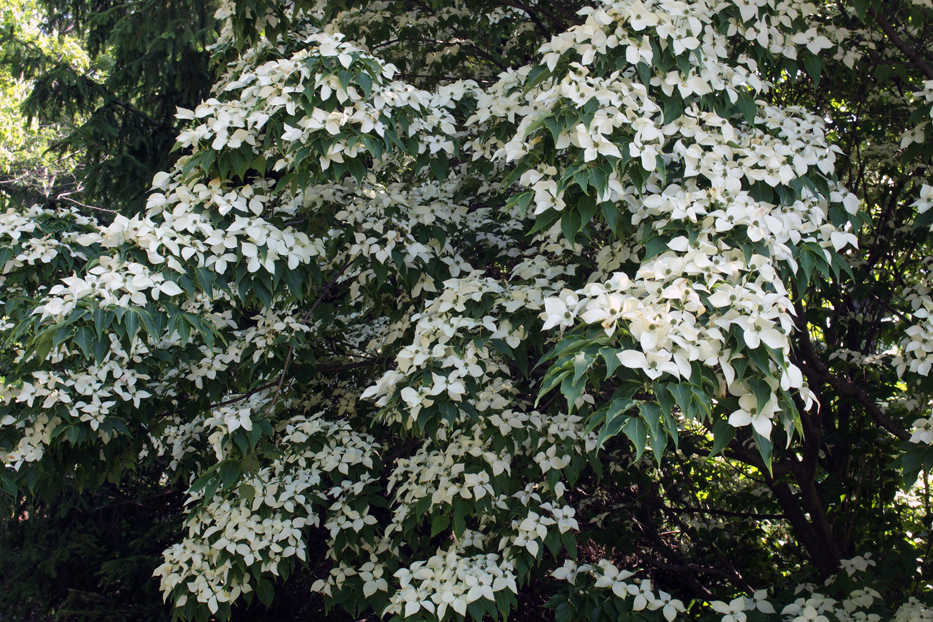The last of the “hounds of spring” is in its glory. Dogwood.
The flamboyant show began back in late winter when cornelian cherry (Cornus mas), a kind of dogwood, swathed its branches in a veil of small, yellow blossoms. That display was followed by one from the familiar flowering dogwood (C. florida), on whose heels, at ground level, came bunchberry (C. canadensis). Then it was the turn of pagoda dogwood (C. alternifolia), its white blossoms on branches tiered like the roofs of a pagoda.
Summer is when white blossoms begin spilling in profusion from among kousa dogwood’s (C. kousa) dark green leaves. These blossoms are especially welcome because they fill the vacuum that follows the burst of color from spring-blooming trees and shrubs.
In fact, what we’ve been admiring from all these “hounds” are not flowers at all. These dogwoods’ true flowers are relatively inconspicuous. The alleged flowers are actually leaves — modified leaves called bracts, which are petal-like in color and in the way they lie in a whorl just behind the true flowers. (Poinsettias also owe their flamboyance to bracts rather than to true petals.)
The only oddball, florally speaking, among these dogwoods is cornelian cherry. Its yellow bracts are relatively small, not much larger than the true flowers. The leaves and bracts make up for their small size by appearing in profusion and in clusters.
Keep an eye on all these dogwoods for the rest of the season, for more good things are still to come. Over the next few weeks, their fruits will begin to turn red — first those of pagoda dogwood, then those of bunchberry and cornelian cherry, and finally those of kousa dogwood and flowering dogwood. Pagoda dogwood’s fruits pass through a red stage on their way to becoming bluish black, but the fruit stalks remain a pleasing coral pink.
Besides good looks, these fruits provide food for wildlife and even, to some extent, humans. The tastiest are cornelian cherry fruits, which, though rarely eaten these days, have been eaten by humans for thousands of years. Remains of these fruits have been found at Neolithic sites in Europe, and the Roman writer Ovid referred to the fruits as part of the Golden Age in his “Metamorphoses.” The plant was common in 18th century English gardens, with the harvested fruit known as cornel plums. Cornelian cherry fruits are still popular in Ukraine.
Fresh cornelian cherries are a bit too robust in flavor for my palate, but if they sit for a couple of days the flavor mellows. Just ripe, or after sitting, they are good in jams, sauces and sorbets.
Kousa fruits, round with protuberances, look like miniature medieval weapons painted pink. They’re slightly sweet and mealy.
Even as the fruits drop from the dogwoods, don’t take your eyes off the plants. As summer cools into autumn, all these dogwoods’ leaves will turn color. Depending on the weather and the species, leaves might put on either a subtle or lively show.
All the dogwoods mentioned here have been purebreds, but some worthy mutts have entered the yard of late. Some result from mating between flowering and kousa dogwood. Elwin Orton of Rutgers University brought these two species together to create the so-called Stellar Series of dogwoods. Stellar Pink is a recently named variety. And the Venus variety is part of the Jersey Star series that Orton created by mating kousa dogwood with yet another dogwood, Pacific dogwood (C. nuttallii).

